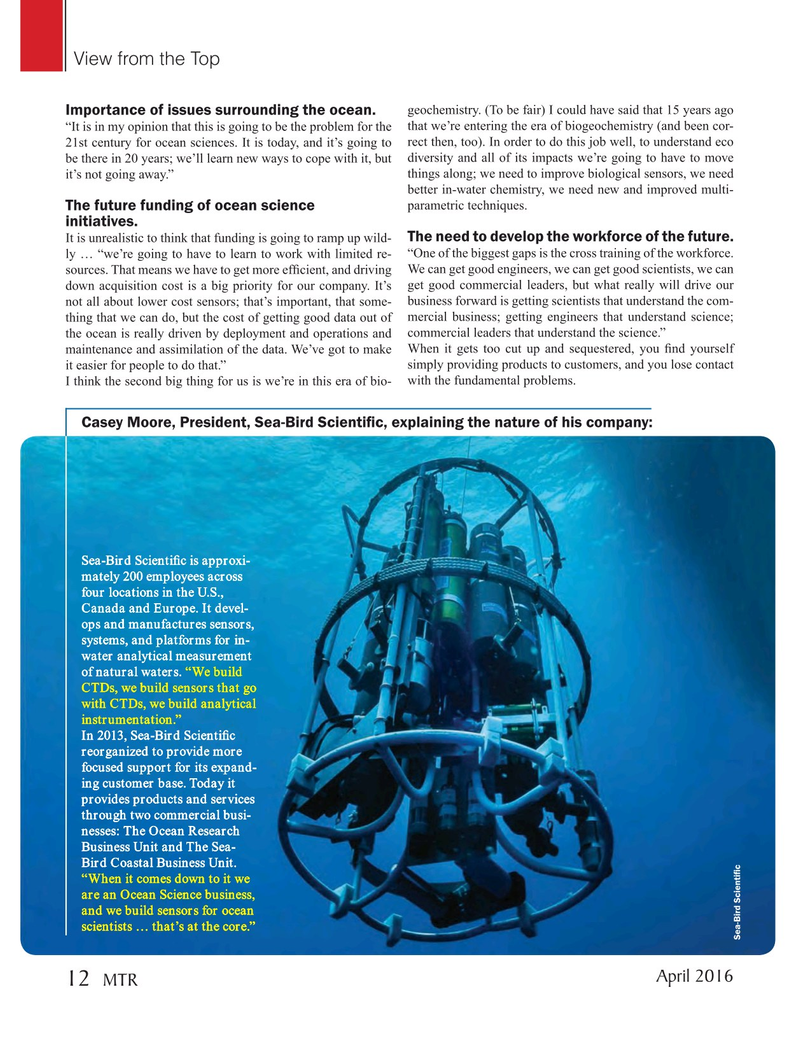
Page 12: of Marine Technology Magazine (April 2016)
Offshore Energy Annual
Read this page in Pdf, Flash or Html5 edition of April 2016 Marine Technology Magazine
View from the Top geochemistry. (To be fair) I could have said that 15 years ago
Importance of issues surrounding the ocean.
“It is in my opinion that this is going to be the problem for the that we’re entering the era of biogeochemistry (and been cor- 21st century for ocean sciences. It is today, and it’s going to rect then, too). In order to do this job well, to understand eco be there in 20 years; we’ll learn new ways to cope with it, but diversity and all of its impacts we’re going to have to move it’s not going away.” things along; we need to improve biological sensors, we need better in-water chemistry, we need new and improved multi- parametric techniques.
The future funding of ocean science initiatives.
The need to develop the workforce of the future.
It is unrealistic to think that funding is going to ramp up wild- ly … “we’re going to have to learn to work with limited re- “One of the biggest gaps is the cross training of the workforce. sources. That means we have to get more ef? cient, and driving We can get good engineers, we can get good scientists, we can down acquisition cost is a big priority for our company. It’s get good commercial leaders, but what really will drive our not all about lower cost sensors; that’s important, that some- business forward is getting scientists that understand the com- thing that we can do, but the cost of getting good data out of mercial business; getting engineers that understand science; the ocean is really driven by deployment and operations and commercial leaders that understand the science.” maintenance and assimilation of the data. We’ve got to make When it gets too cut up and sequestered, you ? nd yourself it easier for people to do that.” simply providing products to customers, and you lose contact
I think the second big thing for us is we’re in this era of bio- with the fundamental problems.
Casey Moore, President, Sea-Bird Scienti? c, explaining the nature of his company:
Sea-Bird Scienti? c is approxi- mately 200 employees across four locations in the U.S.,
Canada and Europe. It devel- ops and manufactures sensors, systems, and platforms for in- water analytical measurement of natural waters. “We build
CTDs, we build sensors that go with CTDs, we build analytical instrumentation.”
In 2013, Sea-Bird Scienti? c reorganized to provide more focused support for its expand- ing customer base. Today it provides products and services through two commercial busi- nesses: The Ocean Research
Business Unit and The Sea-
Bird Coastal Business Unit. “When it comes down to it we are an Ocean Science business, and we build sensors for ocean scientists … that’s at the core.”
Sea-Bird Scienti? c
April 2016 12
MTR
MTR #3 (1-17).indd 12 4/4/2016 9:22:14 AM

 11
11

 13
13
